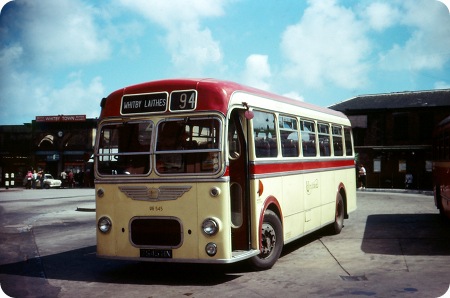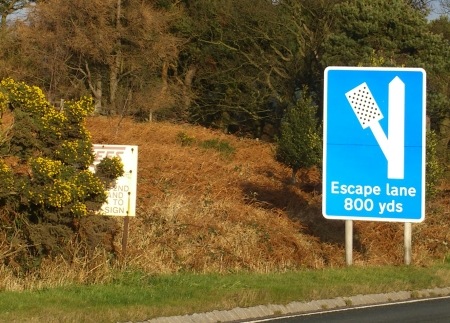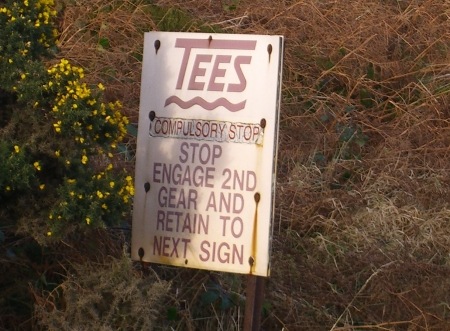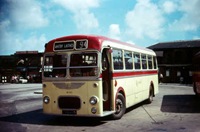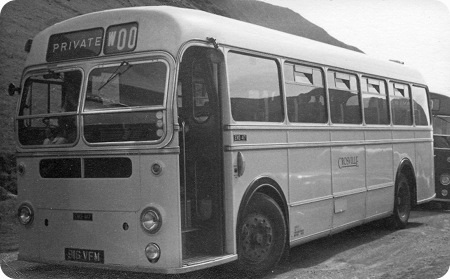West Yorkshire – Bristol MW6G – AWU 466B – 1146
West Yorkshire Road Car Company
1964
Bristol MW6G
ECW DP41F
Originally numbered SMG38, this vehicle became 1146 in West Yorkshire’s 1971 renumbering programme. It was one of twenty-six MW6G buses delivered to WY in 1963/64 – these being the first new single-decker WY buses for some time. For quite a few years previously, the Company had been able to cascade its mid-life dual-purpose vehicles for stage carriage use – repainting them red and cream in the process. The MW6G buses were originally delivered as B45F, but in 1971, SMG33-38 were reseated with high-backed seats from withdrawn LS dual-purpose vehicles. Unusually, the reseated batch retained bus livery, rather than receiving WY’s then dual-purpose/express livery of cream with a red band. As can be seen, ‘T-type’ destination indicators were fitted at the front, but no displays were fitted at the rear. The vehicles sported full-depth rear windows in their nicely rounded domes. They were quiet and comfortable buses to ride in, whether coach or bus seated, not to mention being very reliable and economical workhorses.
Photograph and Copy contributed by Brendan Smith
———
08/09/12 – 07:45
There are so many West Yorkshire experts who visit this site that one needs to be very careful about one’s facts. Someone may know otherwise, but my recollection is that WY fitted high back seats as a matter of course in their early MWs, designated SUGs. I remember them well on route 43, Leeds to Scarborough, always in standard livery. ‘SUG’ was explained to me in conductors’ training school as ‘Single, Underslung Gardner’. ‘SMG’ – ‘Single, Maximum Capacity Gardner’ – came later, I thought, as the company started to fit bus seats. Originally, SUGs had destination indicators made up of the two lower sections of ECW’s then standard three-part screens. The change to ‘T-type’ screens embraced all stage carriage vehicles, in the mid-1960’s. It’s a pity that the screen in this picture is sloppy; even if the screen didn’t have the right destination, (which could occasionally happen), the driver could, I think, have made sure the route number was displayed clearly.
Roy Burke
———
08/09/12 – 07:46
I agree entirely with Brendan about such vehicles being quiet and comfortable to travel in. I had many rides on those of Midland General which were all of the 6G type and always found them so. I’ve never had any experience of the MW5G, I suspect the ride may have been rather different.
David O remarks elsewhere about the popularity of the Guy Arab UF/LUF for coaching work. I too, never had any experience of these but I’ve always imagined that there couldn’t have been much difference between them and the MW.
Chris Barker
———
09/09/12 – 08:02
West Yorkshire vehicles were regular visitors to Blackpool on the "Joint Services" pool and also to Morecambe – alias British West Bradford – on the X88 service from Leeds. We could and did get anything that was available.
The "class" letters seem to have gone from most of the former Tilling group fleets at about the same time, though the Crosville arrangement was adopted by Potteries.
A pleasant enough view, but the indicator display would be of no use at all to a stranger. Thanks for sharing, Brendan.
Pete Davies
———
09/09/12 – 08:02
West Riding were a somewhat surprising recipient of West Yorkshire 1125 825 BWY which was new to West Yorkshire in 1963 as SMG17 in 1974. It lasted with West Riding until 1975 when it was scrapped.
Chris Hough
———
09/09/12 – 08:04
You are indeed right Roy, that West Yorkshire’s earlier deliveries of MWs (MW5Gs) with bus outline bodywork were fitted with high-backed coach seats. They were classed ‘EUG’ when new, denoting Express Underfloor Gardner, as were the earlier batches of LS5Gs, also with bus shells and coach seats. In later life many were demoted to ‘SUG’ status, for use mainly on stage-carriage work, gaining more red to their livery, but retaining coach seats. They would no doubt have been comfortable machines to ride in on the Leeds to Scarborough run, but many of us did wonder why WY continued to specify 5-pot rather than 6-pot Gardner engines for it’s longer-distance vehicles. It must have taken an age to reach Scarborough, Blackpool or Middlesbrough from the heart of the West Riding. (Could that be the reason for fitting half a dozen of the more powerful MW6G buses with 41 high-backed seats later on?). Some of the SUGs were fitted out for "one man" operation in later life, and received 45 bus seats in the process. They were re-classified SMG at the same time, the ‘M’ as Roy says, denoting Maximum seating capacity, and described as such in Ian Allan’s BBF No9. I too have heard this quoted by West Yorkshire staff, but have heard other staff say that ‘M’ meant the bus was suitable for one Man operation. Both descriptions appeared to be very relevant to the buses concerned, but as a skinny apprentice at the time, I did not wish to provoke an argument with either party, and came to the conclusion that maybe they were both right!
Brendan Smith
———
09/09/12 – 08:03
Where was this picture taken Brendan? Judging by the route number, could it have been York, Harrogate or possibly Keighley? As we’ve seen on other postings, it was not uncommon to have to ride many miles on express services in bus seats, but to have this DP for a local suburban estate run must have been delightful!
Paul Haywood
———
10/09/12 – 06:56
Paul and Brendan – my trusty 1960 fare table book (seriously speaking one of my most treasured possessions) may hold the answer to this query. At least in 1960 there was no service 9A in Harrogate or Keighley, but in York services 9/9A ran between Clifton and Tang Hall Lane. Our lovely meerkat friend from TV would no doubt click his teeth and remark "seeemples."
Chris Youhill
———
10/09/12 – 06:58
There are other mysteries here! I know the camera can lie (or the process can) but that’s not Poppy Red, and I’m not sure about the side band- should be a sort of grey-white and yet seems to match the presumably original window surrounds- which would be self-colour cream, I imagine: yet the grey wheels are there and NBC fleetname. As to where… looks too warm for Keighley: has a look of east Leeds about it
Joe
———
10/09/12 – 06:59
I remember seeing the first MWs entering service in Bristol in February 1958. These had AHY registrations and ugly flat backs. The second (DAE) series had the more rounded style and I suppose other early operators of the type had bodywork which went through the same design change.
Geoff Kerr
———
11/09/12 – 06:52
We really need Brendan to tell us where this photo was taken to be sure of the location. In 1960, as Chris says, there was certainly a service 9/9A in York, but it was invariably a double-decker route in those days. I worked it many times as a conductor; a very busy urban route. The picture dates from NBC days – at least 9 or 10 years later – by which time things might have changed, of course. If the picture is indeed in York, things must have changed a lot, since the very idea of OMO on the Clifton/Tang Hall Lane service in the mid-1960’s would have been thought laughable. In Tilling days, York had only one single deck city service, (Leeman Road/Hull Road, route 7), necessitated by a low bridge, operated in my time with L5Gs, (YSGs), later replaced with SUs, (YSMAs). There were then very few OMO routes, and all of them, as you’d expect, were light semi-rural services.
Roy Burke
———
11/09/12 – 06:55
Well Chris- that looked like a York street light, too. Did NBC remove the "York", and have West Yorkshire in East Yorkshire (nearly?) …or is this bus out of area, which explains the blinds?
I should have added that its not West Yorkshire red either which was much redder? This is almost maroon.
Joe
———
11/09/12 – 06:58
Sorry Joe but this is not east Leeds West Yorkshire had no service numbers as low as that in the Leeds area all services in east Leeds were either throughs to York and points east or at a push to places like Barwick Scoles and other dormatory villages which were in the West Riding until 1974 West Yorkshire applied NBC fleet names to standard Tilling red but often painted the cream band on both saloons and deckers.
Chris Hough
———
11/09/12 – 07:01
Apologies for being a little slow in responding to the above comments folks, but I’m making preparations for my ‘jollies’ and have been ‘sidetracked’ away from OB Photos several times! Paul, Chris Y and Joe, sorry to keep you in suspense as a result, but the photo was taken on Woodfield Road, Harrogate. The vehicle was on the newly-introduced 9A Bus Station – Dene Park route, serving a new estate of low-rise flats for older people. From what I can recall, 1146 had been recently transferred from I think, Leeds depot, and presumably had not yet received a blind showing Dene Park, which would go some way in explaining the unhelpful (and slovenly) route display. (There is also what appears to be a maroon Leeds depot allocation disc in front of the fleet number, rather than a green Harrogate one). Joe, your comment on the livery has me puzzled too. I’m not sure whether the processing (AGFA slide) has made the poppy red look like Tilling red, or whether the bus was still wearing Tilling red, with NBC grey wheels, white band and fleetnames applied. Some WY depots did apply white bands and fleetnames to vehicles still in Tilling red, if the paintwork was still sound, pending a full repaint into poppy red at a later date. I smiled at your comment that the view looked too warm for Keighley.
Brendan Smith
———
12/09/12 – 07:11
Thanks for settling this teaser for us Brendan – I had based my wild assumption of the wrong year of course, and on the pretty unlikely possibility of a vehicle transfer or loan to York – and my meerkat informant has received one week’s notice !!
Chris Youhill
———
12/09/12 – 07:11
Brendan, as a Keighley postcoder (although living just over the border into North Yorkshire), I must defend the place! Emily Bronte would have had difficulty selling "Wuthering Heights" with the title "Sunny Hills"! When we think of famous people with "sunny dispositions" we automatically think of Denis Healey, Eric Pickles, and Alastair Campbell who were all born in Keighley! There’s nothing wrong with good old fashioned gloom and misery. Mark my words, no good will come from sunshine, it only attracts the wasps!
Paul Haywood
———
13/09/12 – 06:59
Thanks for settling the mystery, Brendan. I have several views of buses still in Tilling green or red but with NBC style fleetname. A Southern Vectis bus in Southampton (on loan to Hants & Dorset and with the latter’s fleet number – don’t fret, boys, I’ll submit it for consideration in a week or two!) has Tilling green, NBC fleetname and the white stripe.
Pete Davies
Quick links to the - Comments Page - Contact Page - Home Page

